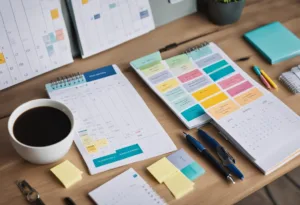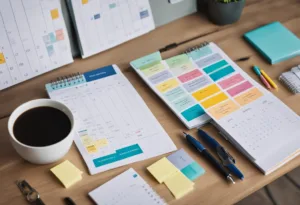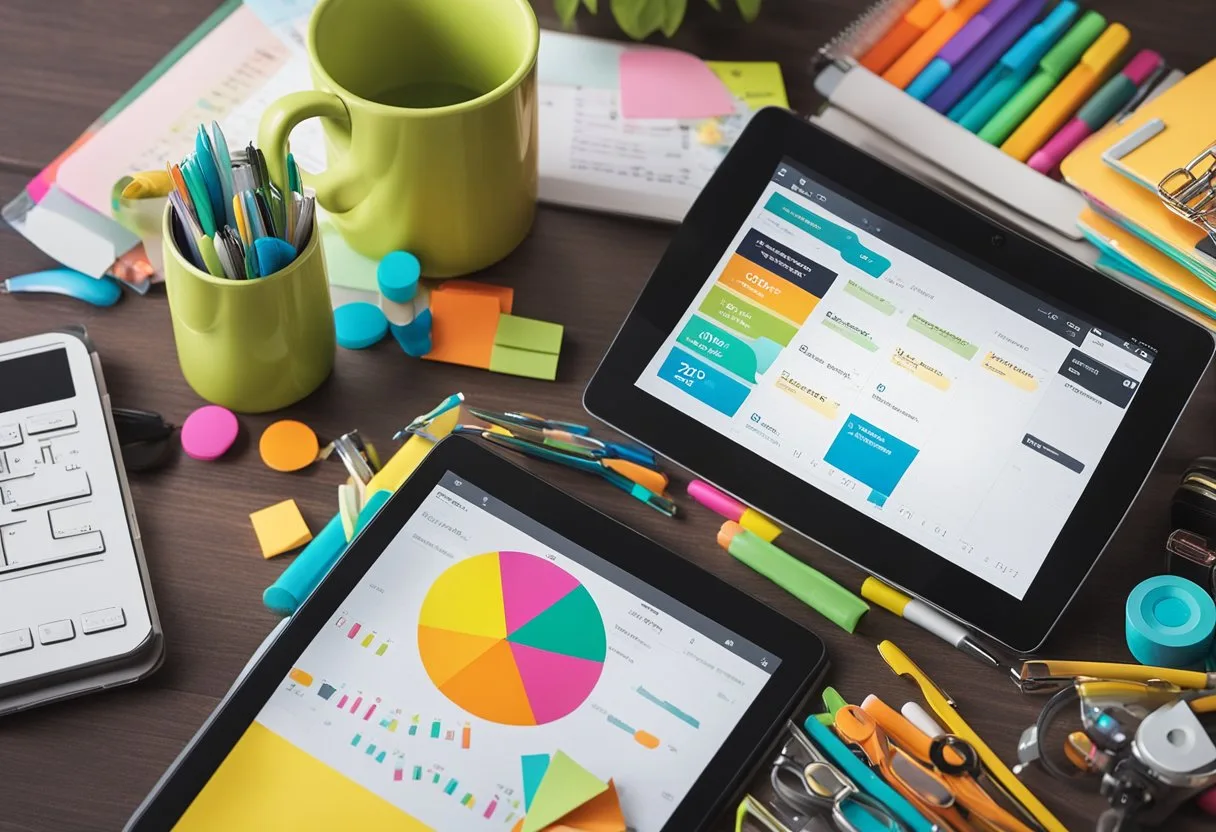Using a planner is a great way to organize your life and stay on top of your tasks and goals. A planner can help you keep track of your schedule, manage your to-do lists, and prioritize your activities. With the right approach, you can use a planner effectively to improve your productivity and reduce your stress levels. In this blog post, I will walk you through how to use a planner to organize your life efficiently and effectively.
To organize your life using a planner, start by setting clear goals and priorities. Identify the tasks and activities that are most important to you and schedule them into your planner first. Be realistic about how much time you have available and don’t overcommit yourself. Use your planner to break down large projects into smaller, more manageable tasks and assign deadlines to each one.
To use a planner effectively, make sure to use it consistently and regularly. Review your planner at the beginning of each day to see what you need to accomplish and adjust your schedule as needed. Use your planner to track your progress and celebrate your successes. Over time, you’ll find that using a planner can help you stay organized, reduce your stress levels, and achieve your goals.
Choosing the Right Planner
When it comes to using a planner to organize your life, choosing the right one is crucial. There are many options to choose from, including digital and paper planners, different sizes, layouts, and types of planners. In this section, we will cover some important factors to consider when selecting a planner that meets your needs.
Assessing Your Needs
Before choosing a planner, it is important to assess your needs. What do you plan to use the planner for? Is it for work, personal use, or both? Do you need to keep track of appointments, to-do lists, or both? By answering these questions, you can determine what features you need in a planner.
Digital vs. Paper Planners
One of the first decisions you will need to make is whether to use a digital or paper planner. Digital planners are convenient because they can be accessed from anywhere and are often synced with other devices. Paper planners, on the other hand, can be more customizable and can provide a more tactile experience.
Planner Sizes and Layouts
Planner sizes and layouts can vary widely. Some planners are small and portable, while others are larger and provide more space for writing. Layouts can also vary, with some planners providing daily, weekly, or monthly views. Consider how much space you need to write and what type of layout will work best for you.
Setting Up Your Planner
When it comes to using a planner to organize your life, setting it up is the first and most important step. This section will guide you through the process of setting up your planner effectively.
Important Dates and Deadlines
The first thing to do when setting up your planner is to identify and record all of your important dates and deadlines. This could include birthdays, anniversaries, meetings, appointments, project deadlines, and more. It is important to have a clear understanding of all of your commitments so that you can plan your time effectively.
To record these dates and deadlines, consider using a monthly planner. This will allow you to see the big picture and plan ahead. Use bold or italic font to highlight the most important dates and deadlines.
Creating a Routine
Creating a routine is an essential part of using a planner effectively. By establishing a routine, you can ensure that you are using your planner consistently and that you are making progress towards your goals.
To create a routine, consider using a weekly planner. This will allow you to plan out your week in advance and ensure that you are making time for all of your commitments. Use bullet points or numbered lists to break down your routine into manageable tasks.
Incorporating Flexibility
While having a routine is important, it is also important to incorporate flexibility into your planner. Life is unpredictable, and you need to be able to adapt to changing circumstances.
To incorporate flexibility, consider using a daily planner. This will allow you to adjust your plans on a daily basis as needed. Use a combination of bullet points and paragraphs to record your daily tasks and any adjustments you make throughout the day.
How To Use A Planner To Organize Your Life

Using a planner is an effective way to organize your life, manage your time, and keep track of all your responsibilities. Here’s a step-by-step guide on how to use a planner to organize your life:
- Select the Right Planner: Choose a planner that suits your organizational style and preferences. Decide between a daily, weekly, or monthly layout, and consider size and portability based on whether you’ll carry it around or leave it on a desk.
- Familiarize with the Layout: Understand the sections and features of your planner. Identify where to write tasks, appointments, and personal notes.
- Input Fixed Commitments: Start by entering all known fixed commitments such as work hours, classes, meetings, and recurring appointments.
- Establish a Planning Routine: Dedicate time each day or week to update your planner. Consistency is key to staying organized.
- Set Goals: Write down your goals, both long-term and short-term, and break them into actionable steps in your planner.
- Plan Your Week: Every week, sit down to plan the upcoming seven days. Include tasks that move you towards your goals, scheduled events, and any deadlines.
- Daily To-Do Lists: Each day, list the tasks you need to accomplish. Prioritize them based on urgency and importance.
- Use Time Blocking: Allocate specific time slots for focused work, errands, and personal activities. This helps prevent overbooking and ensures time for important tasks.
- Track Your Habits: If you’re working on building new habits, use your planner to monitor your daily progress and maintain consistency.
- Review and Reflect: At the end of each day and week, review what you’ve accomplished and what needs to be rescheduled or adjusted.
- Keep It Current: Update your planner regularly with new appointments, changes in schedule, and completed tasks.
- Personalize Your Planner: Use color-coding, stickers, or tabs to make your planner visually appealing and easy to navigate.
- Manage Your Finances: Use your planner to keep track of bills, expenses, and savings goals to stay on top of your financial health.
- Balance Your Life: Ensure your planner reflects all areas of your life, including work, personal time, family commitments, and leisure activities.
- Evaluate and Adjust: Periodically assess how well your planner is working for you. Make adjustments to your planning system to better suit your evolving needs.
Effective Planning Strategies

Effective planning strategies can help individuals manage their time and prioritize tasks to achieve their goals. Here are a few strategies to consider when using a planner:
Time Blocking and Prioritization
Time blocking involves breaking down the day into specific time slots and assigning tasks to each slot. This helps individuals prioritize tasks and allocate the appropriate amount of time to each task. Prioritization involves identifying the most important tasks and completing them first. This ensures that the most critical tasks are completed before moving on to less important ones.
Balancing Work and Personal Life
Balancing work and personal life is crucial for maintaining a healthy lifestyle. When using a planner, individuals can schedule time for work, exercise, family, and other activities. This helps ensure that work does not take over personal life and vice versa. It is important to set realistic expectations and not overload the schedule with too many tasks.
Building Consistent Habits
Building consistent habits is essential for achieving long-term goals. When using a planner, individuals can schedule time for activities such as exercise, reading, and learning new skills. Consistency is key when building habits, so it is important to schedule these activities regularly and stick to the schedule.
By using these planning strategies, individuals can effectively manage their time, prioritize tasks, and achieve their goals. It is important to remember that planning is a continuous process and requires regular review and adjustment.
Organizing Your Tasks and Appointments

When it comes to using a planner to organize your life, the most important aspect is keeping track of your tasks and appointments. This section will explore different methods to organize your tasks and appointments effectively.
Using Lists and Task Management
One of the most effective ways to organize your tasks is by creating a to-do list. A to-do list is an excellent way to keep track of everything you need to do. It is essential to prioritize your tasks and focus on the most critical ones first. Breaking down larger tasks into smaller ones can also help you stay on track and motivated.
Task management tools like Trello or Asana can be helpful in organizing your tasks and keeping track of your progress. These tools allow you to create tasks, assign them to different categories, and monitor your progress.
Color Coding for Clarity
Color coding can be a useful tool to organize your planner. Assigning different colors to different tasks or types of appointments can help you quickly identify what you need to do. For example, you could use a red color for urgent tasks, blue for personal appointments, and green for work-related tasks.
Integrating Technology with Traditional Methods
Integrating technology with traditional methods can be an effective way to organize your life. Google Calendar is an excellent tool for keeping track of your appointments and events. It allows you to create events, set reminders, and share your calendar with others.
If you are tech-savvy, you can use apps like Evernote or Notion to create digital to-do lists and track your progress. However, if you prefer traditional methods, you can use a physical planner and color coding to keep track of your tasks and appointments.
Organizing your tasks and appointments is a critical aspect of using a planner to organize your life. By using lists and task management, color coding, and integrating technology with traditional methods, you can effectively manage your time and stay on top of your tasks.
Maintaining and Reviewing Your Planner
After creating a productivity plan for your week, it is essential to maintain and review your planner regularly to ensure that you are on track and staying organized. Here are some tips on how to maintain and review your planner.
Regular Check-Ins
One of the most important aspects of maintaining your planner is to have regular check-ins. This involves taking a few minutes each day to review your planner and update it with any new tasks or appointments. By doing this, you can ensure that you are not missing anything important and that you are staying on top of your schedule.
Adjusting Your Planning Tools
As you use your planner, you may find that certain planning tools are not working for you. It is essential to adjust your planning tools to suit your needs. For example, if you find that you are not using the monthly calendar section of your planner, consider using it to plan your long-term goals instead. By adjusting your planning tools, you can make your planner work for you and increase your productivity.
Staying Organized Over Time
It is essential to stay organized over time by regularly reviewing your planner and making adjustments as necessary. This means taking the time to review your planner at the end of each week and making any necessary changes to your plan for the following week. By doing this, you can stay on top of your schedule and ensure that you are achieving your goals.
Maintaining and reviewing your planner regularly is essential to staying organized and productive. By having regular check-ins, adjusting your planning tools, and staying organized over time, you can make the most of your planner and achieve your goals.
Frequently Asked Questions

What are the essential elements to include when setting up a life planner?
When setting up a life planner, it is important to include the following essential elements: a yearly calendar, monthly calendars, weekly spreads, and daily pages. It is recommended to include sections for goal setting, habit tracking, and notes.
What techniques can be employed to use a daily planner effectively?
To use a daily planner effectively, it is recommended to start each day by reviewing the tasks and events for the day. Prioritize the tasks and allocate time slots for each task. It is also important to update the planner throughout the day as new tasks or events arise.
How can a weekly planner be utilized to enhance productivity?
A weekly planner can be utilized to enhance productivity by providing an overview of the week ahead. It is recommended to schedule tasks and events for the week and allocate specific days for completing certain tasks. By doing so, it is easier to manage time and ensure that all tasks are completed on time.
In what ways can a planner aid in maintaining organization?
A planner can aid in maintaining organization by providing a centralized location for all tasks, events, and notes. By keeping everything in one place, it is easier to manage time and ensure that nothing is forgotten. A planner can help to reduce stress and increase productivity by providing a clear overview of the day, week, and month ahead.
What strategies can students adopt to make the most out of their planners?
Students can make the most out of their planners by allocating specific time slots for studying and completing assignments. It is also recommended to prioritize tasks and break down larger tasks into smaller, more manageable tasks. Students can use their planners to track grades and deadlines for assignments and exams.
How can someone with a seemingly empty schedule benefit from using a planner?
Even if someone has a seemingly empty schedule, they can benefit from using a planner by setting goals and allocating time for self-care activities, hobbies, and personal development. By doing so, they can ensure that they are making the most out of their time and achieving their personal goals.




